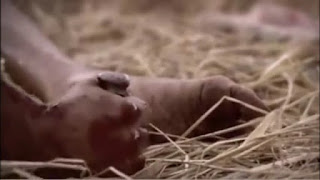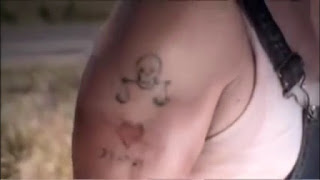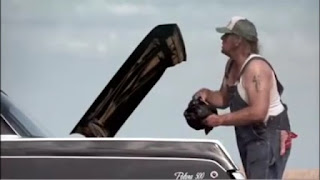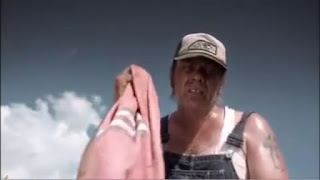This immersive short film, is intended to take the unsuspecting audience and engage them in an emotional roller coaster ride, shifting their perspective of the short film and allowing for their bias view to mislead them in their prediction of the films outcome. The suspense and drama created by the director allows the audience to falsely interpret the piece as a horror extract, the general conventions of the horror genre set the audience up to be at the height of their audio and visual awareness anticipating a jump scare.
Ratthe's intentions do this allows him to take advantage of the audiences emotional attachment to the short film and makes an antic-climatic plot twist that astonishes the audience whilst breaking their perception of reality, this method distances the audience for the film, making them objective spectators as they are now mentally engaged with the film, forcing them to re-evaluate their opinion on the characters. This method of entertainment was first used in theater by director, actor and play writer, Bertolt Brecht. He named it the Verfremdungseffekt, as it alienates the audience.
The short film was hugely successful in captivating the audience in the drama displayed and forced the audience to jump to conclusions by the use of camera shorts, mise-en-scene, sound effects and editing to create the illusion of horror, which in turn was demolished by the sudden realisation of the plot twist.

The opening sequence starts with the opening credits displaying Ratthe's insitution (Matt Ratt Production), followed by the three piano keys accompanied by a blackout, the asynchronous sound of the instrument's slow pace engages the audience as the blackout leaves the audience in a sense of suspense as they await for the film to start.
The black screen fades out to an areal shot with text of the title of the film 'Lovefield' fading in and out as the camera begins to lower to the floor and ambient sounds begin to increase in volume, the various sounds of wind rustling throw the crops, followed by a contrapuntal sound, that fueled suspense, these sounds are communally associated with films based upon horror, being the first misleading factor in creating the haunting atmosphere in which the audience begin to interpret the film as horror. This is successful as the film was intention-ed to shift the reality of the audience, perspective is key when portraying a story in film, the use of sounds leaves the audience in suspence limbo, as they are unable to make any visual interpretation due to the lack of mise-en-scene, making them more anxious and frustrated as they progress through the short film.
 The audience responds to different stimuli and attempt to make sense of what they are experiencing, by intentionally restricting the audiences perception, the film is conveying the a dark atmosphere slower than we can mentally process it, this is what causes the sense of suspense and anticipation as the audience are waiting for the film, to reveal the next major plot point, the anticipation and wait makes the audience more visually and audio aware.
The audience responds to different stimuli and attempt to make sense of what they are experiencing, by intentionally restricting the audiences perception, the film is conveying the a dark atmosphere slower than we can mentally process it, this is what causes the sense of suspense and anticipation as the audience are waiting for the film, to reveal the next major plot point, the anticipation and wait makes the audience more visually and audio aware.The film uses these techniques for the first two minutes of the film, increasing the ambient sounds, and using the camera to make an establishing shot of various locations in the field.
 The pace of the film starts to increase as by this point as a tracking shot retreats backwards, the shot again leaves much to imaginations as it passes a phone, purse full of cash, and bloody knickers, followed by a struggling foot. The various ambient sound fades out as woman can be heard crying and screaming. This is clearly intentional by the director and is successful as the audience was lead to believe that this is a horror film, so by seeing this the audience immediately suspect rape with out considering other possibilities, due to their emotional attachment and bias opinion on the film.
The pace of the film starts to increase as by this point as a tracking shot retreats backwards, the shot again leaves much to imaginations as it passes a phone, purse full of cash, and bloody knickers, followed by a struggling foot. The various ambient sound fades out as woman can be heard crying and screaming. This is clearly intentional by the director and is successful as the audience was lead to believe that this is a horror film, so by seeing this the audience immediately suspect rape with out considering other possibilities, due to their emotional attachment and bias opinion on the film. The was a long pause, filled with silence as the camera moved back, suggesting that the character died, this builds suspense as the audience wait for the cause of death.
The was a long pause, filled with silence as the camera moved back, suggesting that the character died, this builds suspense as the audience wait for the cause of death. There's frequent cuts to a close up of a crow before returning to the scene, among the ambient sounds is the crows squawk which is said to be unlucky and is a common convention of horror movies as it foreshadows something bad is going to happen. Birds have become a clique in creating the daunting atmosphere of a horror movie, famously used as a main antagonist in Alfred Hitchcock's 1963 horror movie which place birds against humanity. It's a horror classic and is critically praised.
There's frequent cuts to a close up of a crow before returning to the scene, among the ambient sounds is the crows squawk which is said to be unlucky and is a common convention of horror movies as it foreshadows something bad is going to happen. Birds have become a clique in creating the daunting atmosphere of a horror movie, famously used as a main antagonist in Alfred Hitchcock's 1963 horror movie which place birds against humanity. It's a horror classic and is critically praised. The camera makes a vertical movement upwards on a close up of the body of a suspected farmer, the shot allows for small details to be emphasised, conveying hidden messages to the audience. The camera scans up the arm of the character reached the upper body to reveal a skull tattoo and a balance, as well as a heart with the word "Mum" inscribed underneath. A skull is another clique convention of horror movies, symbolising death it's a clear indication of what's to come, however contradicting this is the mum tattoo, this could be linked with another one of Alfred Hitchcock's movies 'Physco' released in 1960, it sees hotel manager who's obsessed with his mother even after death as he keeps her corpse rotting away In locked room, the young man dresses up as his mother to commit his violent murders.
The camera makes a vertical movement upwards on a close up of the body of a suspected farmer, the shot allows for small details to be emphasised, conveying hidden messages to the audience. The camera scans up the arm of the character reached the upper body to reveal a skull tattoo and a balance, as well as a heart with the word "Mum" inscribed underneath. A skull is another clique convention of horror movies, symbolising death it's a clear indication of what's to come, however contradicting this is the mum tattoo, this could be linked with another one of Alfred Hitchcock's movies 'Physco' released in 1960, it sees hotel manager who's obsessed with his mother even after death as he keeps her corpse rotting away In locked room, the young man dresses up as his mother to commit his violent murders. From this point onwards the pace of the film picks up as the hands free camera angle creates a shaky and rushed atmosphere. This builds tension creating climax that keeps the audience on the edge of their seats in anticipation It's successful as the sudden panic portrayed contrasts the silent atmosphere that came before.
From this point onwards the pace of the film picks up as the hands free camera angle creates a shaky and rushed atmosphere. This builds tension creating climax that keeps the audience on the edge of their seats in anticipation It's successful as the sudden panic portrayed contrasts the silent atmosphere that came before.The panic sees the farmer character rushing to the car, and attempting the open the boot, the camera is placed in a crab shots as the boot opens, the audience can't see what's in the trunk, creating mystery as the audience guess what's in there, among the consistent sounds of the crow, there's the sound of motel clanging, suggesting that there is an array of tool in the trunk.
 The scene comes to anticlimatic conclusion as it shows that he's picking up a new born baby, however the scene has a huge impact upon the audience as it completely contradicts their view on the short film, as they believed he killed the woman. They film was successful in conveying the message on perspective and judgement as it successfully created a false atmosphere using horror convention to make the audience have a bias view on the short film, this makes the audience a objective spectator as they completely tricked the audience into believing they were watching a horror short film. It teaches the audience not to jump to conclusions as it's a matter of perspective.
The scene comes to anticlimatic conclusion as it shows that he's picking up a new born baby, however the scene has a huge impact upon the audience as it completely contradicts their view on the short film, as they believed he killed the woman. They film was successful in conveying the message on perspective and judgement as it successfully created a false atmosphere using horror convention to make the audience have a bias view on the short film, this makes the audience a objective spectator as they completely tricked the audience into believing they were watching a horror short film. It teaches the audience not to jump to conclusions as it's a matter of perspective.




I love this short film :)